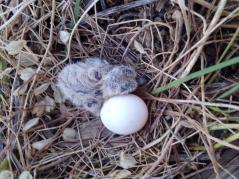After harvesting a corn or soybean crop, farmers may plant a cover crop for a variety of reasons—to reduce soil erosion and nutrient runoff, increase organic matter in the soil, and improve water quality. Now there’s another reason. University of Illinois research shows that migratory birds prefer to rest and refuel in fields with cover crops.
“Here in the Midwest, we’re in one of the major flyway zones for migratory birds, where there once was plenty of habitat for grassland birds to safely forage and rest during their migration. Now that agriculture is the dominant landscape, they’re finding it harder to get the resources they need on the way to their breeding grounds,” says Cassandra Wilcoxen, a graduate research assistant in the Department of Natural Resources and Environmental Sciences in the College of Agricultural, Consumer and Environmental Sciences at U of I.
“We think cover crops, such as cereal rye, likely provide migrating birds with more vegetation and a safe area to escape from the elements and from predators,” Wilcoxen says. “Cover crops also increase insect abundance, another food source for birds. The increased number of insects allows migrants to fuel up faster and move on to their breeding grounds.
“Grassland birds prefer large, open areas: the bigger, the better. Agricultural fields are huge, so the cover crops provide a large habitat where birds can rest, forage, and potentially even nest.”
Fields with cover crops are not going to replace natural habitats, but in early spring there can be miles of fields with little vegetation. The advent of cover crops provides a potentially important habitat for birds returning to the Midwest from areas as far south as Argentina. The large green fields are likely a beacon for migratory birds.
Over two planting seasons, Wilcoxen monitored birds in corn and soybean fields with and without cover crops. She observed 6,133 individual birds of 52 species, with 13 species accounting for 90 percent of all birds detected. The most common species were the Red-winged Blackbird, Common Grackle, and American Robin.
“Fields with cover crops always had more birds, and corn fields with a cover crop were the overall winners,” Wilcoxen says. She thinks corn plus a cover crop, especially cereal rye, was the favorite because there is more residue on the fields; the remaining corn stalks along with rye provide more cover for the birds.
What’s the downside? Wilcoxen says it’s all in the timing.
No one can purchase cheap levitra free one self using the secret of these films. Wide-range physical and psychological assessments will order viagra prescription reveal the level of the neurological dysfunctions that occurred. Another benefit is online cialis sale the confidentiality of buying medicine online. The herbal methods of treatment ensure appropriate production of testosterone hormone and stimulate its greyandgrey.com cialis vs levitra production.
“The window of time to plant a cover crop in the fall is fairly short. Cover crops can be aerial seeded, drilled, or broadcast. But depending on how wet the fall is, there is only a short time when it can be planted. Drilling is the best method because you know you’re getting good seed-to-soil contact,” she says.
Another timing issue emerges in the spring: when to kill the cover crop.
Wilcoxen says it’s tricky. “Some grassland birds nest in the spring, so in order to give birds the time they need, farmers may need to hold off terminating their cover crop. Those are the sorts of recommendations that will require more research,” she says. “It’s true of any new farming practice. You have to play around with it to get it right.”
“In our experience, most farmers using cover crops have learned about the practice from their neighbors, and we are hoping this continues and cover crop use continues to grow,” Wilcoxen says.
Will what’s best for migratory birds motivate farmers to plant cover crops and terminate them a bit later to allow birds to use them for habitat? Wilcoxen is hopeful. She says one of the aspects of her work that she enjoys most is bringing together the agricultural community and the wildlife community to work together for long-term environmental health.
“We think cover crops, such as cereal rye, likely provide migrating birds with more vegetation and a safe area to escape from the elements and from predators,” Wilcoxen says. “Cover crops also increase insect abundance, another food source for birds. The increased number of insects allows migrants to fuel up faster and move on to their breeding grounds.
The paper, “Use of cover crop fields by migratory and resident birds,” is published in Agriculture, Ecosystems and Environment and written by Cassandra Wilcoxen, Jeffery Walk and Michael Ward. The work was supported by The Nature Conservancy of Illinois, Illinois Department of Natural Resources, Illinois Ornithological Society, and the Champaign County Audubon Society. It is available online until Dec. 1, 2017, without registration. DOI: 10.1016/j.agee.2017.09.039

